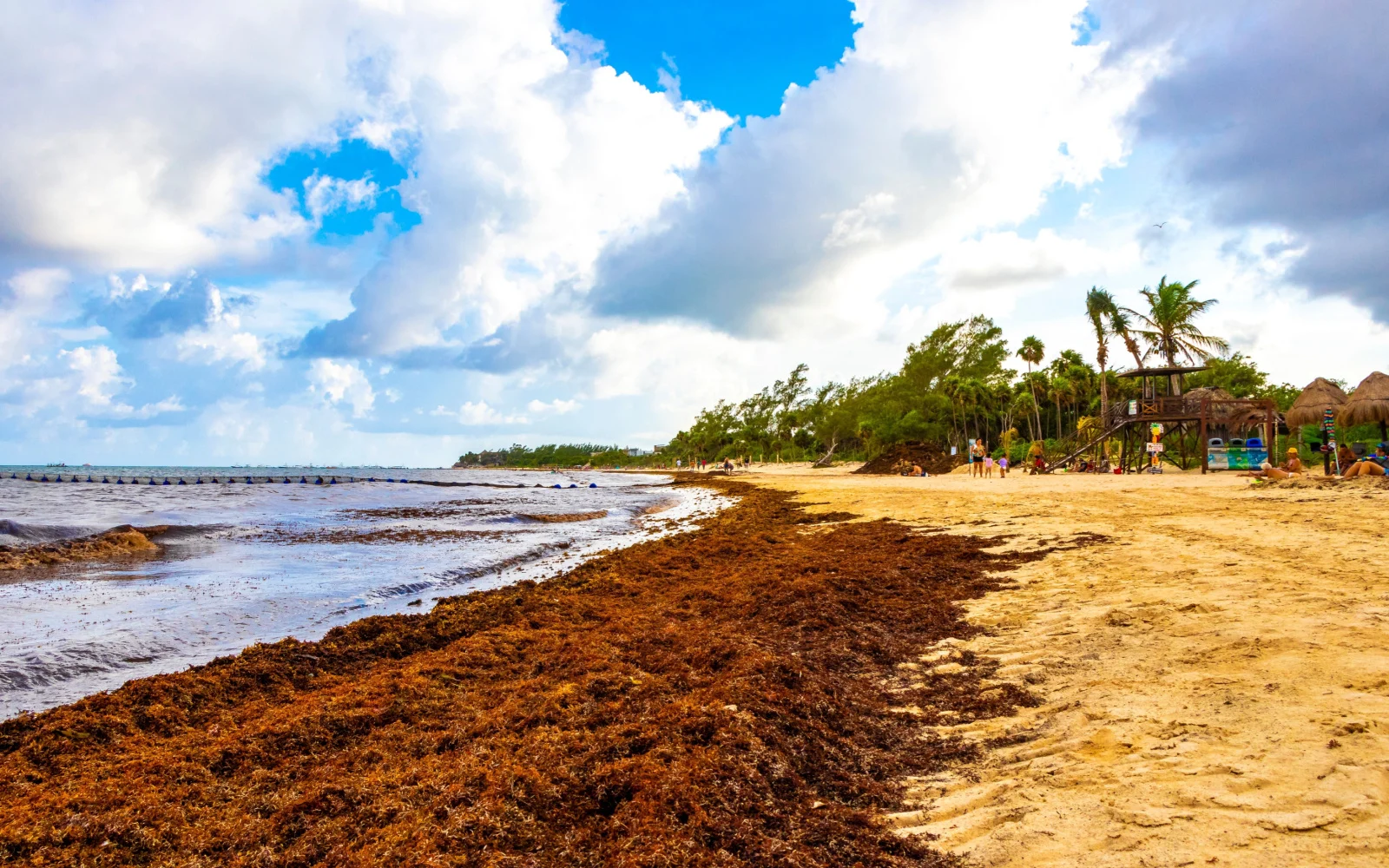What is Cancun's seaweed season?
Cancun seaweed, primarily sargassum, can negatively impact beach experiences by creating unpleasant odors, unsightly scenes, and limiting beach access. To avoid sargassum, travelers should check seaweed season dates and plan visits outside this period, typically from mid-October to early February, for a better chance of enjoying clean, seaweed-free beaches.
Cancun seaweed can make the beaches smelly, messy, and much less inviting for spending time relaxing on the sand. If you’re hoping to avoid sargassum in Cancun, check the seaweed season dates to plan your vacation around it!
Knowing when the Cancun seaweed season starts and ends will help you avoid the worst periods and enjoy clean, pristine, seaweed-free beaches.
What Is Cancun Seaweed?
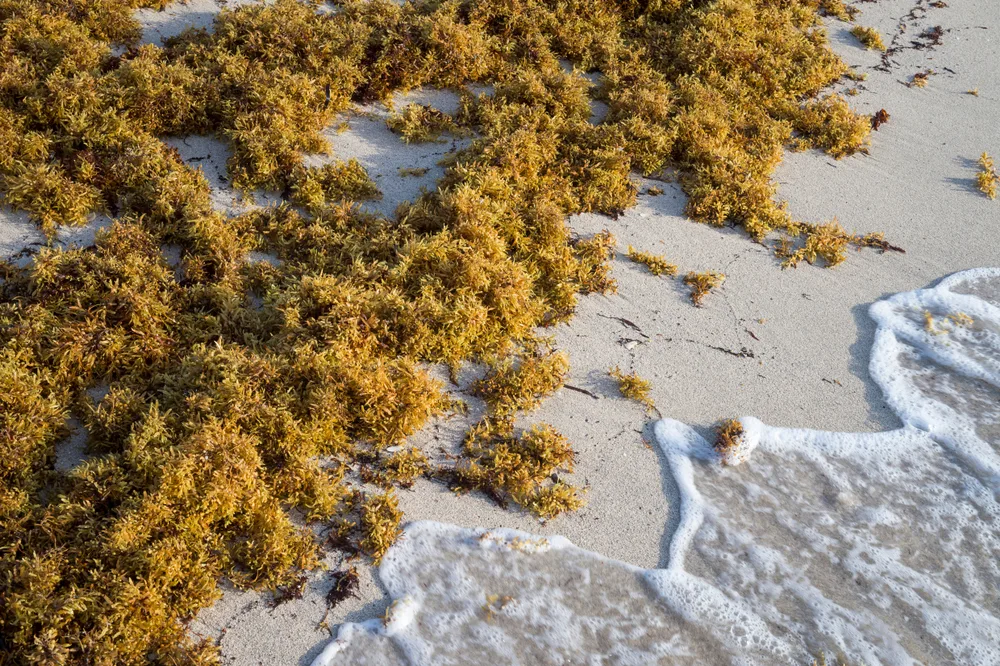
lazyllama/Shutterstock
The brown, stinky seaweed you’ll see littering the beaches of Cancun is typically sargassum. So what is sargassum – the notorious Cancun seaweed – and why does it plague the beaches here?
Sargassum is a type of brown algae or seaweed that floats in giant masses, or clumps, on top of the water thanks to tiny oxygen-buoyed bladders that keep it afloat.
The masses of sargassum can be miles long. In fact, NASA imagery has estimated around 13 million tons of the smelly seaweed floating in the Great Atlantic Sargassum Belt in 2023.
Eventually, these masses of brown sargassum wash ashore due to ocean currents and litter Cancun beaches with their rotten-egg odor and limit access to areas of the beach.
The sargassum doesn’t just affect Cancun. Beaches throughout the Caribbean – except those protected by mangroves or natural barriers – all the way down to Argentina experience a sargassum influx during certain parts of the year.
Keep reading to learn about the issues seaweed causes on beaches in Cancun, the peak and low season for seaweed here, and how to sidestep the unpleasant seaweed season in Cancun.
✔️ Absolute Necessities in Cancun:
- Private Airport Transfer from Cancun Airport to Resort (Super affordable!)
- Cancun Airport MERA Lounge Access (Tickets almost always sell out day of)
🛎️ Our Top Resort Picks:
- Atelier Playa Mujeres – Modern and luxurious. Great for honeymoons
- Turquoize at Hyatt Ziva – Adults-only, amazing seascapes
- Le Blanc Spa Resort – Ultra-luxurious, adults-only, private beach & great pools
Why Is Cancun Seaweed a Problem?
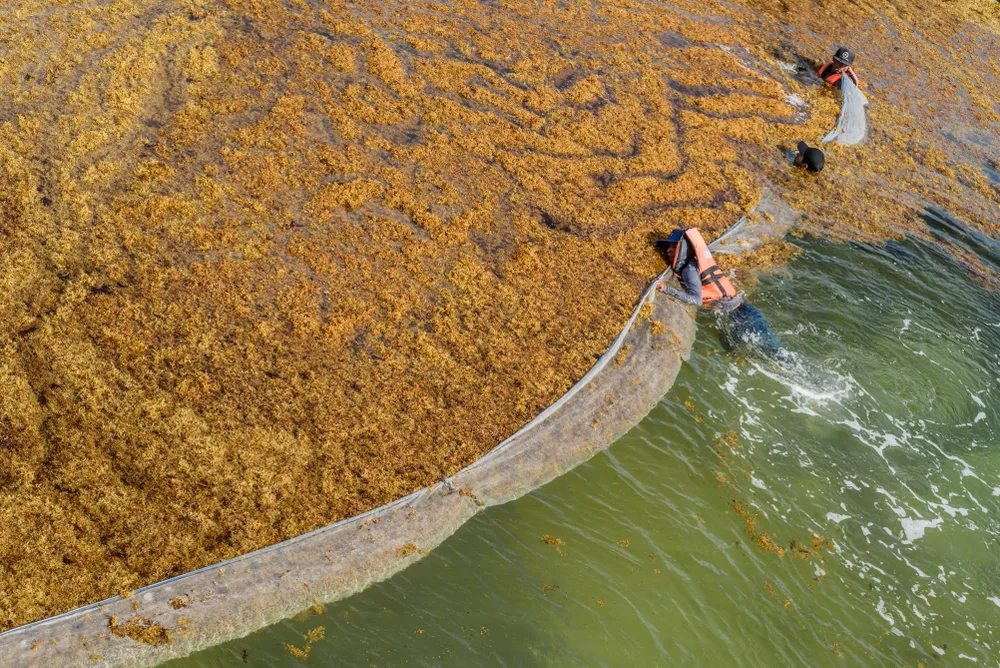
Workers, “Sargazeros,” cleaning the beach in the Riviera Maya/Bret Reyes/Shutterstock
Cancun seaweed is an issue with wide-ranging consequences for visitors, locals, the regional ecosystem, and tourism and hospitality industries in Mexico.
But what makes seaweed in Cancun such a problem? There are 5 core issues stemming from the annual sargassum influx.
- Smelly and unpleasant with a pungent rotten egg odor as it breaks down
- Unsightly, littering the white-sand beaches with clumps of brown seaweed
- Inconvenient for beach trips as it limits beach access and swimming
- Can be dangerous to humans when washed ashore
- Growing issue with widespread negative effects
1. Unpleasant Odor
Ask anyone who’s been to a beach covered with sargassum seaweed can tell you: This stuff is seriously smelly and makes beach experiences much less pleasant.
The odor is similar to rotten eggs because sargassum releases hydrogen sulfide gas as the organic matter breaks down in the hot sun in huge clumps on the shore.
2. Unsightly
The masses of seaweed don’t just stink – they’re also unsightly and can ruin the pristine appearance of Cancun’s white sand beaches.
Those picture-perfect Cancun beach photos and idyllic scenes can easily be ruined when sargassum comes to town.
When seaweed season hits Cancun, vast stretches of sand get covered in these brownish clumps with small grape-sized air bladders. It’s not exactly everyone’s idea of a beautiful beach vacation.
3. Limits Beach Access
Smelly and unsightly, the masses of sargassum also inconvenience beachgoers in Cancun.
As the tides push these floating mats of algae onto the shore, they mound and cover large areas of the sandy beach, limiting the best access to the water (unless you want to walk through the masses).
4. Can Be Dangerous
And while sargassum is not usually dangerous to humans on its own, it contains a small amount of arsenic (don’t ingest it) and is a natural habitat for tiny marine life and organisms that can sting, pinch, or irritate skin.
Jellyfish larvae (sea lice) and tiny crabs often live in the clumps of seaweed that have washed ashore, meaning you’re in for an unpleasant sting or pinch if you pick it up, walk through it, or lie down in it.
Once sargassum is on the shore and beginning to rot, it releases hydrogen sulfide gas (that’s what creates the distinct rotten egg smell) that can cause respiratory issues, skin problems, and cognitive issues in humans who breathe it in.
5. Widespread Effects
The seaweed in Cancun also poses a tourism and ecological issue as it affects the marine and land environments here, along with the people, animals, and organisms nearby.
As sargassum builds up on the shore, it can erode beaches long-term. The arrival of these masses of seaweed also makes the area less suitable for tourists, especially when it’s at its worst.
While sargassum is still floating in the ocean, it can restrict the amount of light marine plants receive, causing oxygen levels in the water to plummet and killing marine life.
When sargassum dies off, it sinks to the ocean floor and can kill delicate corals and seagrasses where it falls. As it breaks down, it raises the acidity of the water and further increases ocean temperatures.
When Is the Cancun Seaweed Season?
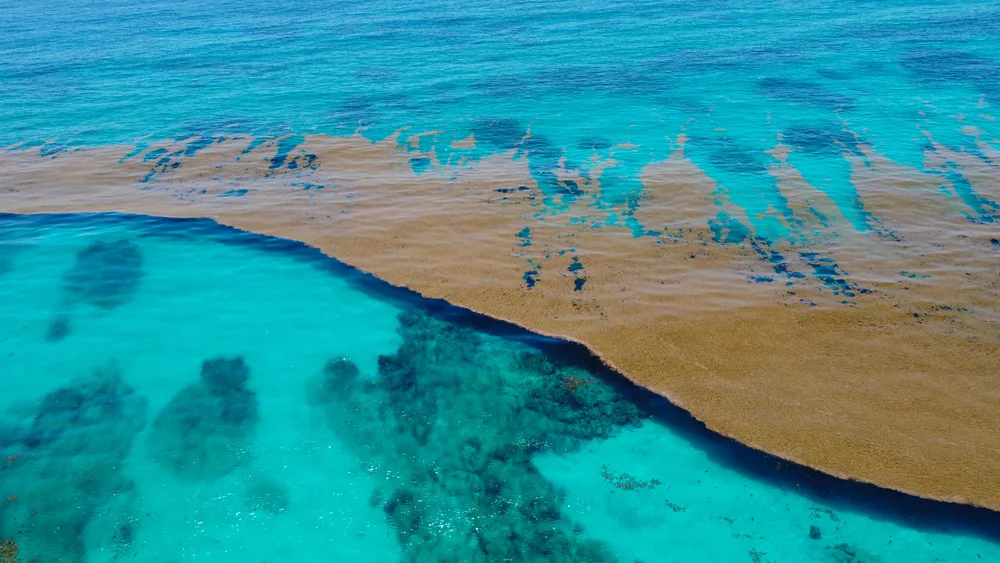
BogDarena/Shutterstock
- Seaweed season lasts from February-October in Cancun
- Peak seaweed levels occur June-August
- Seaweed season is getting longer in Cancun
Cancun’s seaweed season usually lasts from March to mid-October, but that may be changing as ocean waters warm up earlier and sargassum starts washing ashore sooner.
The seaweed season in Cancun can arrive as early as February, as it did in 2023. The season usually begins closer to March and April, but warming ocean waters have led to earlier seaweed arrivals on Cancun beaches.
During the earliest part of the season (February-April), many beaches in Cancun still have very little to no seaweed on the shore.
As temperatures in the water warm up throughout the spring and summer season, the Cancun seaweed really becomes a problem for beachgoers and is visible on nearly every Cancun shore.
By mid-October, the ocean temperature has cooled enough to make conditions less hospitable for seaweed. The sargassum dies off and is no longer washing ashore in most areas of Cancun at this time of year.
Best Time to Avoid Cancun Seaweed
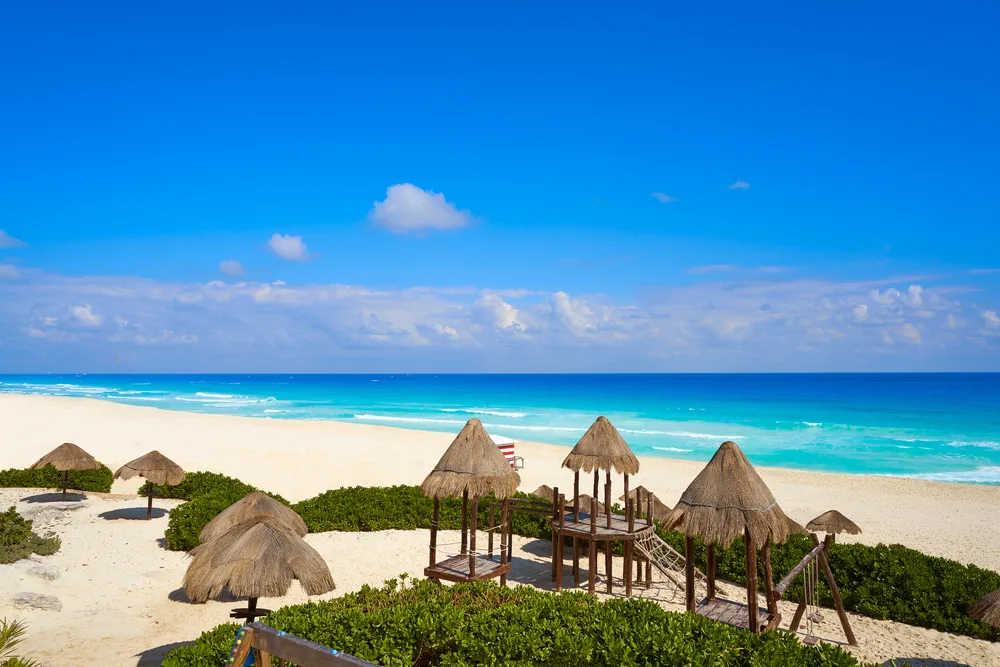
lunamarina/Shutterstock
If you want to avoid Cancun seaweed altogether, the best time to go to Cancun is from mid-October to early February when there’s no sargassum on the beaches.
Cancun’s seaweed problem is nonexistent from mid-October to early February, and sometimes all the way into March or April. The sea temperatures are too cool for sargassum during this time of year.
As a result, you can expect the clean, pristine white-sand beaches that Cancun is famous for if you plan a visit sometime between mid-October and February, possibly extending into March and April.
Worst Time for Cancun Seaweed
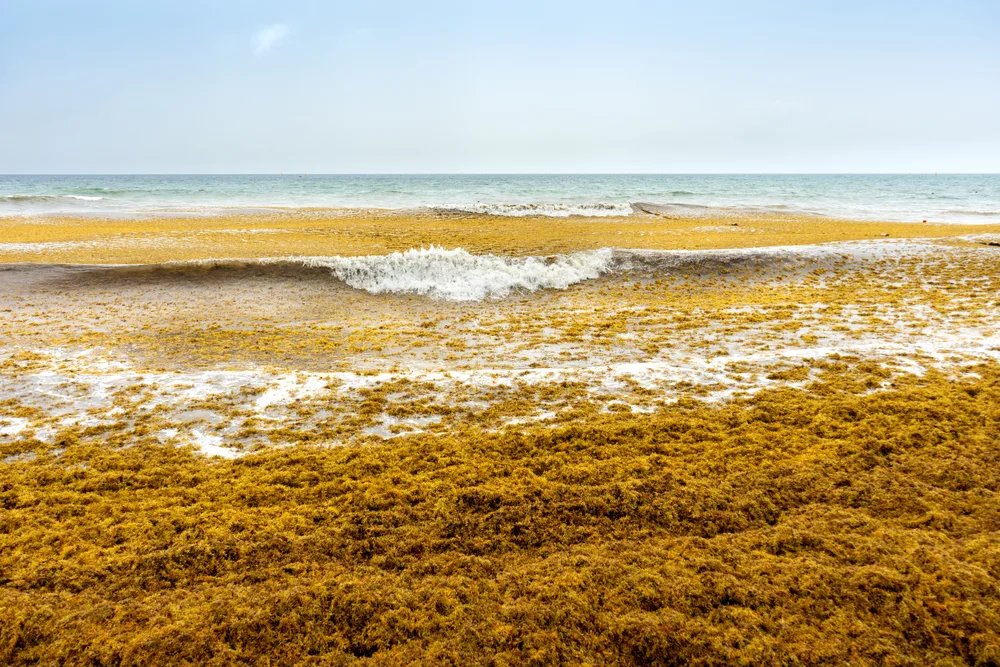
Guajillo studio/Shutterstock
The worst time for seaweed in Cancun is usually March to early October, with peak months typically from June to August.
Sargassum thrives in warm temperatures, making it a real problem once the ocean starts warming up into the upper 70s. This makes spring and summer the worst time for Cancun seaweed.
The optimal water temperature for sargassum occurs sometime between February and March in Cancun, when the ocean temperature is around 77F-79F.
As the seaweed clumps grow and spread for miles throughout the Atlantic and Gulf of Mexico, currents bring them onto Cancun beaches between February at the earliest all the way through mid-October.
This is the period to avoid – especially June through August – if you don’t want to have a smelly, inconvenient run-in with sargassum on your Cancun getaway.
How to Avoid Cancun Seaweed
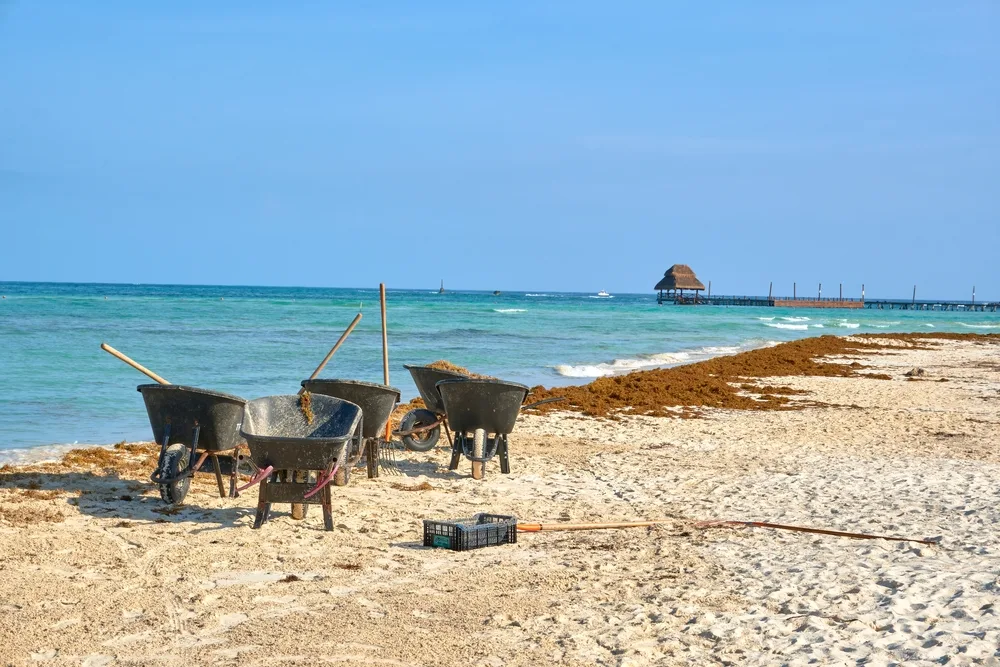
Israel Solorzano/Shutterstock
If you want to make the most of your Cancun beach vacation, you may need to take a few steps to skirt the seaweed problem. Here are the best ways to avoid seaweed in Cancun!
Visit Cancun Outside of Peak Seaweed Season
The easiest way to avoid Cancun’s sargassum problem is to visit the area outside of the peak seaweed season. That means planning your visit sometime between mid-October and early February to be on the safe side.
Most years, Cancun doesn’t experience a lot of sargassum until March or April. But in 2023, the seaweed arrival occurred in February as the ocean warmed up sooner than expected.
If you can plan around the arrival of sargassum, you won’t have to look for resorts and hotels that manually remove seaweed daily or have large barriers in place to combat it.
Avoid the Most-Affected Beaches During Seaweed Season
The most-affected Cancun beaches that experience heavy seaweed are Del Nino, Playa Coral, Chacmool, Las Perlas, Ballenas, Marlín, and Delfines.
You can avoid visiting these sargassum-stuffed beaches during seaweed season to reduce your chances of running into huge masses of seaweed on the shore when you’re trying to relax, swim, and enjoy a day at the beach.
You can also consider visiting Isla Mujeres, a small island a short ferry ride across the bay from Cancun, where you’ll find the least sargassum in the Mexican Caribbean region.
Stay Up-to-Date on Seaweed Status
Mexico’s government and tourism industry knows that seaweed in Cancun is a real problem for visitors and locals. They regularly update seaweed status for different beaches and areas in Cancun to help people plan around it.
Follow government and hotel social media pages to get daily updates on the levels of sargassum and photos that can help you gauge the effect it’s having on the area.
Sargassum maps are often used to show the beaches and regions experiencing the worst or least-problematic levels of seaweed around Cancun.
Sargassum levels are also monitored daily with an easy-to-understand color-based ranking system, much like is used for currents and riptides.
- Green means little to no sargassum
- Yellow means moderate levels of sargassum
- Orange means high levels of sargassum
- Red means excessive levels of sargassum
If you see green or yellow indicators for the beach areas you plan to visit, it shouldn’t be much of a problem.
If you see orange or red indicators, it’s a sign that it may be best to avoid that area if you’re not aware of sargassum-clearing efforts taking place.
Choose Hotels Making Seaweed Removal Efforts
High-end hotels and all-inclusive resorts in Cancun are the best places to head if you’re going during the peak seaweed season and want to avoid dealing with this issue.
That’s because the higher-end hotels and resorts make huge efforts to consistently clear and remove sargassum from their private beaches on a daily basis.
It’s not great news for people who enjoy traveling on a budget, but cheaper hotels just don’t have the funds to cover daily manual sargassum clearing.
If avoiding sargassum is important to you, make sure your hotel consistently monitors and clears the seaweed by asking a staff member or checking online before reserving your room.
Some of the hotels and resorts that are known to remove sargassum daily are:
- Jashita
- Banyan Tree Mayakoba
- Andaz Mayakoba
- Paradisus Playa del Carmen
- Chable Maroma
Almost every top-notch beachfront hotel and resort in Cancun will make daily efforts to clear and remove the stinky, unsightly sargassum from the beach. Just make sure to ask before you book!
Things to Consider
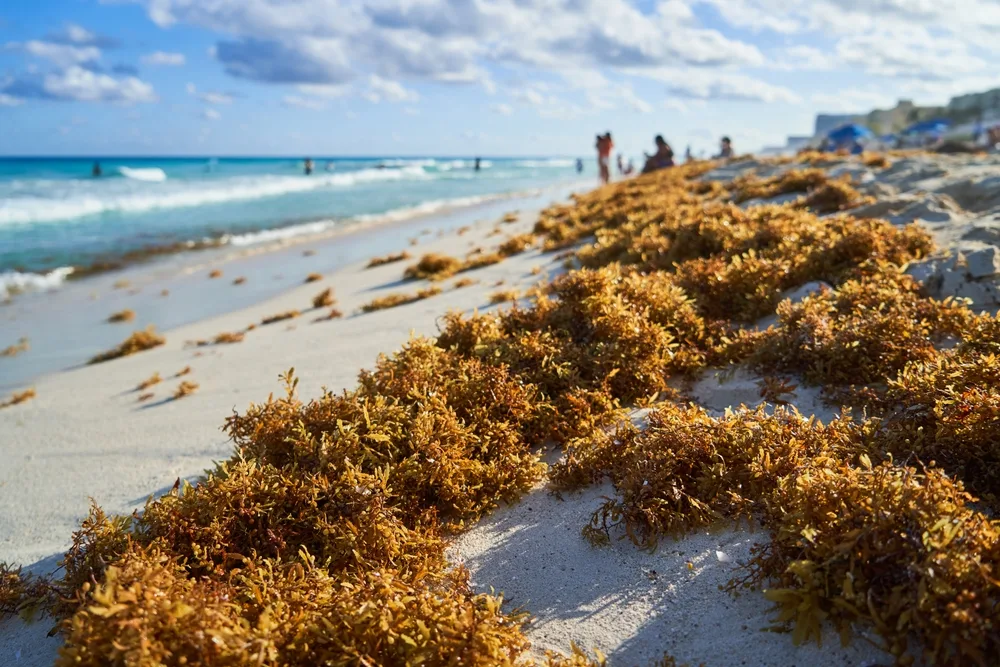
Fabian Montano Hernandez/Shutterstock
What else should you know and keep in mind to steer clear of the dreaded Cancun seaweed? Here are a few helpful travel tips to keep your beach trip clean and pristine.
- Head to the top of the “7.” Cancun’s beaches (and by association, most popular hotels and resorts) are arranged in the shape of a 7. The beaches and resorts near the bottom of the 7 tend to get more seaweed than those at the top. Head to the areas in the “upper 7” like Playa Tortugas, Playa Langosta, Playa Ancha, and Caracol Beach to get a better chance at avoiding sargassum.
- Public beaches get cleared as much as possible. Mexico takes the seaweed issue seriously because it has such an effect on tourism. Even the public beaches are regularly cleared to ensure there’s room for beachgoers to enjoy the sand and shore without the stinky seaweed nearby. Tractors, shovels, and sargassum boats are used to try and keep the beaches clean.
- Enjoy the pool instead. If you arrive in Cancun during seaweed season and can’t stand the smell or the way it limits your access to the water, head to the pool instead. The smell of sargassum is strong, but shouldn’t be a problem when you’re off the beach unless the air current is strong or your hotel is directly on the beach.
- Hop on a boat. You can still enjoy the ocean in Cancun if you come during peak seaweed season – you may need to get off the beach, though! You can rent a boat or take a boat tour or cruise to check out beautiful nearby islands, wildlife, fishing, and more.
- Check the sargassum status before you go. Lots of websites and social media accounts monitor the levels of sargassum across Cancun on a daily basis to help travelers stay informed. You can check out social media accounts for the hotel you’re staying in or look at more general sites like Sargassum Monitoring.
Frequently Asked Questions
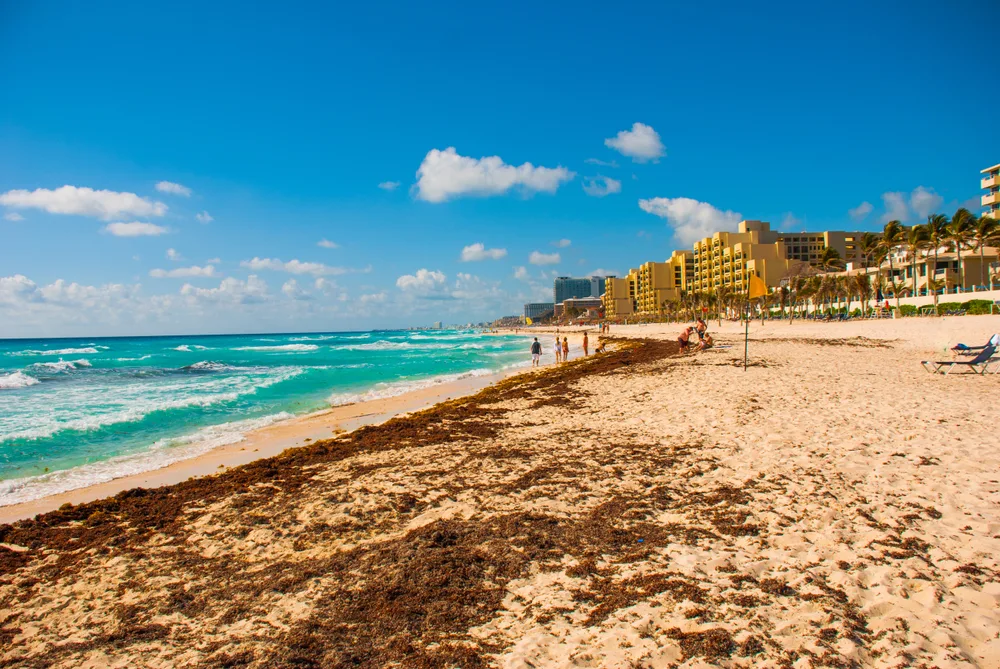
Anna ART/Shutterstock
You probably have a few more questions about Cancun seaweed and what you need to know to best avoid it or deal with it. Check out the most frequently asked questions below to learn more!
Is seaweed still a problem in Cancun?
Cancun seaweed continues to be a problem for tourists and beachgoers. In fact, sargassum amounts in March 2023 broke records in Cancun.
As the seaweed problem worsens, more efforts are being made to remove and reduce the amount that ends up on beaches with equipment, barriers, and more.
What months does Cancun have seaweed?
Cancun experiences its peak seaweed season from June to August, but you'll find sargassum on the shores of Cancun from about February-March to mid-October.
What time of year is the seaweed the worst in Cancun?
Cancun seaweed is at its peak from June to August, with the expected peak during the month of June in 2023.
Warm water helps sargassum thrive, so as the ocean cools off around October through February, seaweed isn't a concern.
What part of Cancun has no seaweed?
Every part of Cancun deals with some degree of sargassum seaweed during the seaweed season, but some areas are better than others.
The northern beaches in Cancun may have less seaweed than those further south. Nearby Isla Mujeres (a short ferry ride away) has the least seaweed of any Mexican Caribbean beach.
Is there sargassum in Cancun 2023?
Yes, sargassum seaweed is in Cancun in 2023. In fact, the amount of seaweed in Cancun in 2023 has broken records by arriving earlier than usual (February) and in higher amounts.
Over to You — Book Your Trip Today!
The seaweed problem in Cancun can make beach experiences smelly, unsightly, inconvenient, and potentially dangerous (though that’s really rare). But does it mean you should cancel your trip?
Cancun seaweed can be an issue from February to mid-October, but it’s only at its worst from June to August. If you’re planning on visiting outside of this 3-month peak period, it won’t ruin your trip!
Even if you plan to go to Cancun between June and August, the sargassum season doesn’t have to be a deal-breaker.
If you plan activities off the beach, choose hotels and resorts that manually clear the shore daily, and try to stick to the northernmost beaches that deal with less seaweed, you can still have a great time.
Cancun’s sargassum seaweed problem isn’t going away anytime soon, but efforts to reduce and continually remove these organic mats from the shore are beginning to make headway.
Since Cancun has so much to offer tourists – yes, even beyond those beautiful white sand beaches – it’s totally possible that seaweed on the beach won’t interfere with your visit.



